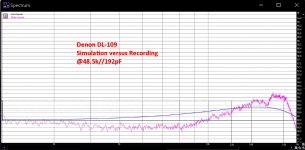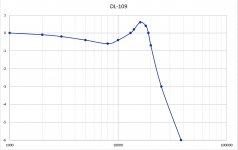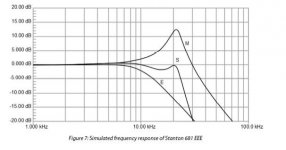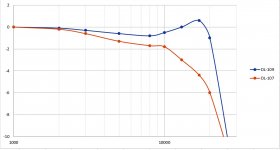I have spotted the following cartridge US patents from Denon (in each various names) at https://www.freepatentsonline.com/
US3084228A (04/22/1960) Piezo
US3360616A (06/25/1963) Ribbon
US4161631 (07/13/1978) MC1
US4488284 (09/30/1982) MC2
US4455639 (08/22/1983) MC3
US3627931 (01/23/1968) MM1
US4209669 (12/21/1978) MM2
I haven’t found an MC patent preceding the manufacturing of the DL-103.
DL-103 was designed/assembled in 1965 for radio broadcasting studios. https://www.denon.jp/ja-jp/museum/products/dl103_2.html
It was commercialized in 1970.
Denon Museum lists thirteen DL-103 models from 1969 to 1994
https://www.denon.jp/ja-jp/museum/index.html
(only to test Bill's reflexes 😈 )
George
US3084228A (04/22/1960) Piezo
US3360616A (06/25/1963) Ribbon
US4161631 (07/13/1978) MC1
US4488284 (09/30/1982) MC2
US4455639 (08/22/1983) MC3
US3627931 (01/23/1968) MM1
US4209669 (12/21/1978) MM2
I haven’t found an MC patent preceding the manufacturing of the DL-103.
DL-103 was designed/assembled in 1965 for radio broadcasting studios. https://www.denon.jp/ja-jp/museum/products/dl103_2.html
It was commercialized in 1970.
Denon Museum lists thirteen DL-103 models from 1969 to 1994
https://www.denon.jp/ja-jp/museum/index.html
(only to test Bill's reflexes 😈 )
George
I don’t know of any test records in current production that have the range, scope and quality of the old CBS, Shurs and JVC test records. If you know of any, please add links. I certainly would like to get some new ones.Back in the day was 50 years ago. We have new and better tools now, which is great. Note I am not saying those ones are wrong, just that in discussions on here enough questions have been posed to make me think they might need recalibrating.
effective tip mass and LF resonance are real. Effective tip mass is real, even though it's inferred rather than measured. But is vinyl compliance real? All the analyses I have seen assume a rigid cantiliever and assume hooke's law holds for a non-static case. A totally rigid cantilever doesn't make sense to me personally so I prefer to consider a world where there is cantilever flex and it's a transmission line. But willing to be persuaded that I am wrong.
The pink noise disc you are using is a rather blunt instrument. Any low level effects, resonant or otherwise, are buried under a broadband high level stimulus.
Yes, vinyl compliance is real enough. A flexible cantilever does not change this. The end result of both is the response of the hf resonance as modified by the flexible cantilever.
Last edited:
Don’t mean to repeat myself, but how can you detect low level effects in the presence of a high level broadband stimulus?And finally tonight a cartridge people may at least have heard of, the technics snappily named EPC205C-IIL. It's younger brothers the mk3 and mk4 are famed as some of the greatest MM ever made but IMO this one is no slouch. Plus I can't afford the more fabled brethren. The L model has a very low inductance coil which should make it less sensitive to capacitive loading, so lets see how it did. For a cartridge older than my wife 😉 it did pretty well. Second picture here shows deviation from the simulation and this is around 0.3dB at 20kHz.
None of this is AES grade data but really not seeing anything to even hint at a mechanical resonance. Now of course I'm not expecting to find anything so I may be blinkered, but data is there for you.
You still have not provided details of this test disk. L+R, 45/45 stereo, level, etc.
Last edited:
It's perfect for the topic of discussionThe pink noise disc you are using is a rather blunt instrument. Any low level effects, resonant or otherwise, are buried under a broadband high level stimulus.
If it's real you can show us some evidence of it in play? I've not found any so must have been looking in the wrong place.Yes, vinyl compliance is real enough. A flexible cantilever does not change this. The end result of both is the response of the hf resonance as modified by the flexible cantilever.
We are not looking for low level effects we are looking for ANY evidence of a mechanical resonance being used to modify the frequency response. Nothing more. You appear to be reading far more into this experiment than there is.Don’t mean to repeat myself, but how can you detect low level effects in the presence of a high level broadband stimulus?
You still have not provided details of this test disk. L+R, 45/45 stereo, level, etc.
Details of the test disk have been requested, but it relies on the producer replying to an email. Patience please.
@MarcelvdG there is 'something' on one channel at 24kHz but not on the other, so I suspect something else there. Above 20kHz we don't have a test method we can use for that. Needs more thought.
I thought I saw a peak in both channels, although for some reason only about 1 dB in one channel and 3 dB in the other.
40 year old cartridges with stylii of unknown history can throw things up. We might retest with different loadings to see if that brings anything out. It’s good harmless fun after all.
No, your test disc is not looking fit for purpose. Buy, beg or borrow a disc with a slow sweep.It's perfect for the topic of discussion
If it's real you can show us some evidence of it in play? I've not found any so must have been looking in the wrong place.
We are not looking for low level effects we are looking for ANY evidence of a mechanical resonance being used to modify the frequency response. Nothing more. You appear to be reading far more into this experiment than there is.
Details of the test disk have been requested, but it relies on the producer replying to an email. Patience please
Compliance is a consequence of a material‘s elastic properties. The effects of disc compliance on pickup response have been studied since the forties or fifties. For starters, see Barlow’s paper in the AES journal July/Aug 1978. The references therein are important to read.
In case my comment on blunt instruments it wasn’t clear, low level resonances may have been excited with your stimulus which you cannot see in your data. Why don’t you just follow tried and true practices and run a slow sweep in one channel? Excite one channel, record the output from both channels and see what shows up. Also, did you look at Paul Millers data I posted up thread? Do see resonances there?
Last edited:
Why? Honest question as you seem to be dissing our test approach without understanding what we are doing. Really looking for gross effects here, with multiple dB changes to the signal level. Crosstalk which you mention from single channel sweeps is a whole other rabbit hole, which has been circled on threads here and gets fun when you look at the cutting head as well.No, your test disc is not looking fit for purpose. Buy, beg or borrow a disc with a slow sweep.
If they start with a static deformation model I am really not interested in paying $30 for an article, sorry. I do have Walton's articles and he mentions nothing about compliance.Compliance is a consequence of a material‘s elastic properties. The effects of disc compliance on pickup response have been studied since the forties or fifties. For starters, see Barlow’s paper in the AES journal July/Aug 1978. The references therein are important to read.
In case my comment on blunt instruments it wasn’t clear, low level resonances may have been excited with your stimulus which you cannot see in your data. Why don’t you just follow tried and true practices and run a slow sweep in one channel? Excite one channel, record the output from both channels and see what shows up. Also, did you look at Paul Millers data I posted up thread? Do see resonances there?
We are not following tried and true practices on purpose here. The whole point of this thread was to question some oft repeated belief that MM cartridges need to have a mechanical resonance to flatten the response. In case you missed it I'll put the graph from Van Raalte's linear audio paper here again (with Kind permission of the publishers). That seems to be an accepted view by many. I and some others think this is wrong so we proposed to test it. I mean why would a MM need this if a MC doesn't. Makes zero sense. I've looked at enough of Paul Miller's data to feel there are issues with his test methodology as he follows the same path everyone else has.
We are trying something different, which goes against perceived wisdom for a reason. What if they've been wrong for the last 50+ years? Won't win any awards, but would be fun to see if we could get some good evidence. I'm cool with people thinking I am a deluded fool tilting at windmills. I have been called much worse by people, even the kids 😀
Attachments
Billsurv,
It is doubtful you will be able to move forward without learning about the prior state of the art. If you are genuinely serious about this topic, and not just internet chat, you’d pay up for a year’s membership in the AES or go to your local public library and ask for public access to the journal and get reprints through that library. There never was any question that electrical parameters and mechanical effects were juggled in order to get flat(ish) response. This was written up by Shure when they introduced one of their new V15s. Don’t have the reference handy.
As for the other points, I’m not going to engage further.
It is doubtful you will be able to move forward without learning about the prior state of the art. If you are genuinely serious about this topic, and not just internet chat, you’d pay up for a year’s membership in the AES or go to your local public library and ask for public access to the journal and get reprints through that library. There never was any question that electrical parameters and mechanical effects were juggled in order to get flat(ish) response. This was written up by Shure when they introduced one of their new V15s. Don’t have the reference handy.
As for the other points, I’m not going to engage further.
I promised myself I would not engage further, but against my better judgment am suggesting another article:
Ben Bauer, JAES, July 1964.
When Ben Bauer speaks vinyl audiophiles should listen.
Ben Bauer, JAES, July 1964.
When Ben Bauer speaks vinyl audiophiles should listen.
These show some response curves.
https://sites.google.com/site/zevaudio/turt/cartridge-comparison-list/shure-v15v
https://sites.google.com/site/zevaudio/turt/cartridge-comparison-list/shure-1000e
And see fig. 5 in Shure's cartridge technical seminar here:
https://sites.google.com/site/zevaudio/turt/cartridge-comparison-list/shure-v15v
https://sites.google.com/site/zevaudio/turt/cartridge-comparison-list/shure-1000e
And see fig. 5 in Shure's cartridge technical seminar here:
Attachments
He's starting from an innacurate electrical model again, so may be coming to the wrong conclusion. I don't have either of those cartridges.
If it's the figure 5 I think you are talking about this is the intriguing bit that suggests Shure were well aware of the transmission line model for a cantilever but decided not to discuss that further.And see fig. 5 in Shure's cartridge technical seminar here:
Trawling through the data so far we have found one oddity which is the DL-109

This is the pink noise response rotated to flat to make it easier for human eyes and the simulated response plotted over the top. Extracting the deviation from simulated we get

Now this looks very like a cantilever resonance, which is what we have been seeking, but the +/-0.5dB is far less than one might expect from a resonant peak. Next step will be to change the loading to flatten the electrical response out and see if this moves with it or changes. The DL-107 with a higher tip mass does not seem to show this, so I think I need to roll out some bonded tip stylii for additional tests.

This is the pink noise response rotated to flat to make it easier for human eyes and the simulated response plotted over the top. Extracting the deviation from simulated we get

Now this looks very like a cantilever resonance, which is what we have been seeking, but the +/-0.5dB is far less than one might expect from a resonant peak. Next step will be to change the loading to flatten the electrical response out and see if this moves with it or changes. The DL-107 with a higher tip mass does not seem to show this, so I think I need to roll out some bonded tip stylii for additional tests.
Yes, on p. 25 the shank simulation model is shown. The following figs. 6 and 7 show some simulation results.Which of the many figures 5 do you mean?
This was in the 70s, so they are relatively crude results.
Last edited:
If I recall correctly they used an analog computer for much of this work. old skool stuff!
Interesting graph comparing simulation vs measurement for the Denon DL-107 and 109. now the 107 was a late 60s vintage radio DJ cartridge. Fairly robust cantilever and big diamond. The difference should give us the frequency response of the moving parts, with a few fudge factors for the conical profile which won't all the way to 20khz. The 107 shows none of the mechanical peak that the 109 appears to have and just rolls off after 10kHz.
Interesting graph comparing simulation vs measurement for the Denon DL-107 and 109. now the 107 was a late 60s vintage radio DJ cartridge. Fairly robust cantilever and big diamond. The difference should give us the frequency response of the moving parts, with a few fudge factors for the conical profile which won't all the way to 20khz. The 107 shows none of the mechanical peak that the 109 appears to have and just rolls off after 10kHz.
Attachments
True, I wonder what the R&D budget of shure was like then compared to cartridge manfacturers today?
- Home
- Source & Line
- Analogue Source
- mechanical resonance in MMs

